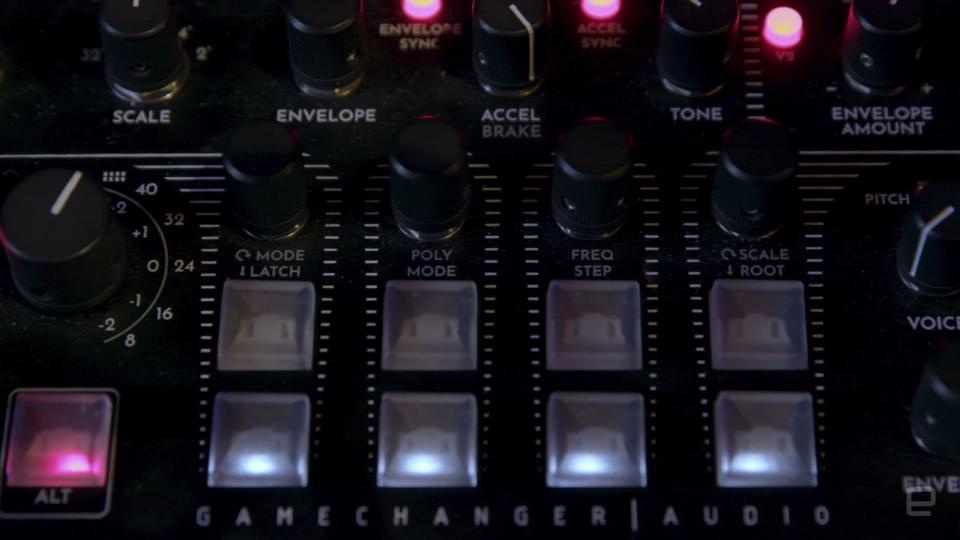Drone motors make wonderfully grungy synth music
Gamechanger Audio’s Motor Synth is unlike anything you’ve ever seen (or heard) before.
There's no shortage of ways for synthesizers to generate sounds. Generally they rely on one of two tried and true technologies -- analog or digital oscillators. Gamechanger Audio, however, went a completely different route and turned to... motors (hence Motor Synth). These aren't the chaotic, gas-burning engines you'd find in a truck though. These are eight high-precision, brushless motors (like those used in drones).
So how does it work?
Well, it's actually pretty simple. The motors spin at a specific RPM that corresponds with a particular audio frequency. For example, plug in a MIDI keyboard, press middle C and the motors will immediately start whirring at a frequency of 261.63Hz. To be clear, what you hear when you press that button isn't the actual sound of the motors. (Though they are, unsurprisingly, quite audible.) Instead, magnetic pickups are used to capture the electromagnetic energy through induction, which is then turned into musical notes.
The result is unlike anything I've heard come out of a synthesizer before. It's aggressive and rough, but still thoroughly enjoyable. There's a slight natural waver to the tones that's reminiscent of an old analog synthesizer but different in a way that's hard to explain.

If this was all the Motor Synth did, it would still be pretty impressive -- if a bit one dimensional. Gamechanger has another trick up its sleeve though: reflective discs that sit on top of each motor. Those discs have patterns painted on them, and as they spin under a light inside, the black markings also absorb heat. The unpainted sections reflect that heat back to a set of infrared sensors. That data is then converted into audio signals -- either sine, saw or square waves. They sound much closer to a traditional analog synth but still have a character all of their own.
One of the best parts is that you get to see all of this happening, because there's a window you can view the eight motors through. You can actually watch as they spin up and slow down in response to your playing. Best of all, they're bathed in an appropriately angry-looking red light.
Beyond this, things start to look much more like a traditional synthesizer -- and that's not a bad thing. Because when you're starting off with an idea this bizarre, you need something to help ground it in the familiar. There's a standard ADSR (attack, decay, sustain, release) envelope, a multi-mode resonant filter (which can be bypassed), a drive circuit for adding distortion and a mod section that can add tremolo or vibrato or even affect the filter envelope.
The only control here you won't see on other synths is the accelerate knob (which doubles as a brake). This changes how quickly the motors get up to speed and how quickly they come back down. It might sound slightly odd, but it's essentially a glide control.
There are a number of different connectivity options too. There are CV (control voltage) ports for pitch, clock and gate; a 1/4-inch output for line-level audio; a USB port; plus a standard five-pin MIDI DIN. There's also a 1/4-inch input jack that not only accepts audio but also can do pitch tracking -- which means you could play the Motor Synth using a guitar, bass or even your voice. That said, we can't make any promises about how well the pitch tracking will work, since it's not up and running yet.

Now, while you can hook up a traditional keyboard and play the Motor Synth just like any other synthesizer, the folks at Gamechanger prefer to use the eight buttons on the front. These can be set to play any scale, making it easy to bang out a melody or bassline, even if you don't know how to play an instrument. And they can be either momentary (notes stop playing when you release the button) or latching (notes play until you play new notes). The latter is particularly useful for when you switch from free play to arpeggiator mode.
When you're using the arpeggiator, you'll definitely want to put the Motor Synth in mono or unison mode to avoid things getting cacophonous. When in unison it uses all eight motors simultaneously to play each note. The results are chest-rattling basslines and leads that are difficult to tame. This is definitely an instrument better suited to more-aggressive styles of electronic music like industrial or digital hardcore. (Is that still a thing?)
If you're going to use the Motor Synth in four-note polyphonic mode, your best bet is to hook up an external keyboard. While it's fun to jam on the eight-button front panel, it feels limiting when you're trying to play chords. Be aware that while you can play pads, they're going to be unlike anything you'd get on other synths. They're pretty rough around the edges, but not metallic. They'd probably make for a great horror movie score.

We only had a short amount of time with the Motor Synth at the Brooklyn Synth Expo. But I'm pretty excited about its potential for creating one-of-a-kind sounds. There's tons of depth left for me to explore and it's still a preproduction unit, so lots of features aren't working yet. Gamechanger Audio doesn't expect to start shipping these until December, so there's plenty of time to get things right. And hopefully once it does, we'll have the opportunity to do a full review.
But if you want to be among the first to get your hands on one, you can back the Motor Synth on Indiegogo for $899. If you choose to wait for retail availability, that price is expected to shoot up to around $1,299.

